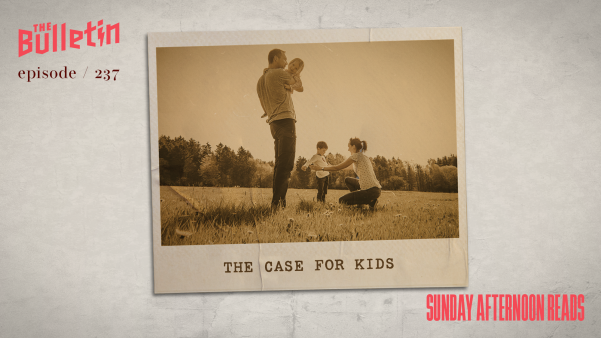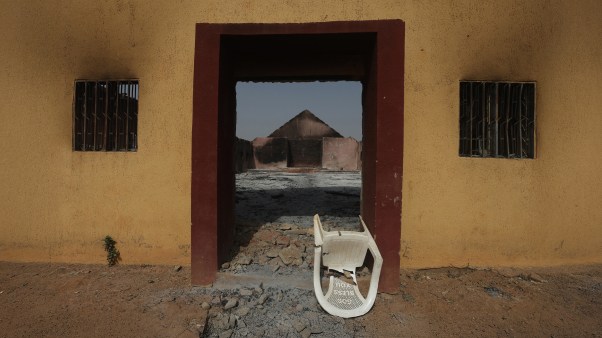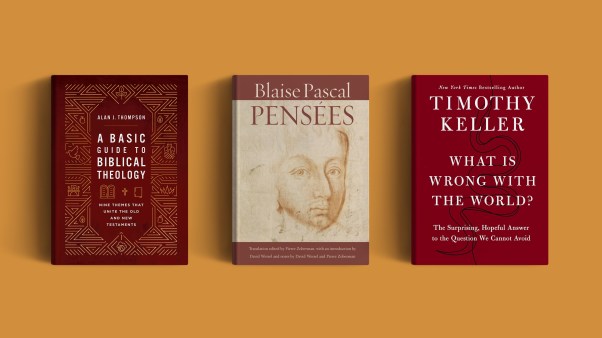I grew up believing women could do it all. In rural South Dakota, I was surrounded by farm women, who are some of the toughest, most resilient people I have ever met. My mom could bake delicious chicken and also slaughter them.
South Dakota also frequently leads the nation in the percentage of women and mothers who work outside the home. So as a young girl, I never doubted that women could do whatever they wanted, that they were as equally capable as men. I could become president. I could be an astronaut. I could do whatever I set my mind on doing.
But as I prepared to do so, I discovered a gap between what I had always been told and what I now saw—and that gap was distinctly female-shaped. Despite the many women visible in the workforce in South Dakota, women felt largely invisible when it came to the work of theology. My home church had never had a female preacher. During seminary, I had one female professor. In my doctoral studies, I had two, but none in my religion classes.
I was confident that Scripture supported women in teaching and leading the church: Women were the first to proclaim the gospel (Luke 24:5–12), and Paul names women like Junia and Phoebe, who acted as apostles and deacons (Rom. 16:1, 7). But compared to the pages and pages dedicated to Peter and Paul, Augustine and Aquinas, Calvin and Luther, women often felt like names merely mentioned in the margins.
I wanted more than names. I wanted to see women leading. I wanted to see women teaching. I wanted to see their faces and hear their stories. I wanted exemplars I could imitate: women who, with Paul, could say, “Imitate me, just as I imitate Christ” (1 Cor. 11:1, NLT).
I wanted heroes.
Eventually, on a trip to Italy, I found them. It was there I realized that the witness of women isn’t hiding in the margins. It’s written plainly. We just need to look at the inscriptions on the walls.
I spent a good chunk of my time in Italy staring at stones. I was fascinated by the Colosseum, impressed by the grandeur of St. Peter’s, and marveled at the architectural perfection of the Pantheon. Most astonishing of all, however, was discovering that what I had struggled to find in ink and paper I could see clearly in stone and paint. Here, in and on the walls of ancient churches, I found my heroes.
In Rome, I discovered churches not only named after Mary but also after Anastasia, Susanna, Agnes, and Sabina. When I wandered into some of these ancient churches, I discovered the connection was far deeper than a name written on a wall. In several of the churches, women were literally the foundation the church was built upon—the walls were built around their bones.
Tertullian famously said that “the blood of the martyrs is the seed of the church,” and 1 Peter 2:5 describes the church as the “living stones” that are “being built into a spiritual house to be a holy priesthood.” So when ancient Christians built their places of worship, they often did so on the bodies of believers who lived so profoundly for Christ that they gave their lives for him.
The martyrs were both the metaphorical and literal bedrock of the church. At the center—the heart—of the ancient church stood the Eucharistic altar, which usually contained the bones of Christian martyrs and saints. Their bodies, and their willingness to follow Christ to his death, acted as an example and a sign of what the Eucharist celebrates and calls the faithful to become. Taking bread and wine from a tombstone acted as a potent reminder that believers must die with Christ to be resurrected with him.
Consequently, while scholars still debate whether women led the Eucharist in the early church, there is no debate over whether women were foundational to its celebration. Their tombs—and therefore their bodies—were the building blocks not only of the Eucharist but of the entire church.
In Ravenna, I saw their faces. Alongside Peter, Paul, and the rest of the apostles, Perpetua, Felicity, Daria, Euphemia, Cecilia, and Eugenia peered out at me from the glittering, intricate mosaics in the Archbishop’s Chapel of St. Andrew. These female heroes lived such lives of holiness that the early church wanted women and men to look up to them, both figuratively and on the wall; to be inspired by their witness and to follow their example. Here—right in front of my eyes—were women leaders of the church who were such authoritative teachers and exemplars that even the archbishop, one of the highest authorities of the church, looked to them for guidance.
And there were more. In the Basilica of San Vitale, Empress Theodora stood equal in size and standing to her husband, Justinian. Along the length of the walls in the New Basilica of Saint Apollinaris, each side featured a procession of saints marching toward Christ. On the left was a line of women, and on the right, the men, equal in stature, equal in standing. The design and placement of the mosaics mirrored each other, so that as I stood in the church, I could plainly see what it meant for men and women to be “one in Christ” (Gal. 3:28). These weren’t women hiding in the margins or in the background but visibly leading the church toward Christ.
These early church heroes were distinctly concerned with their experience as women. And they weren’t afraid to talk about their female bodies.
Perpetua and Felicitas, two of the women featured in the Archbishop’s Chapel, prepared for their martyrdom by talking openly about their breasts, nursing, and childbirth. Imprisoned in second-century North Africa, both women refused to renounce their faith, even though Perpetua had just given birth and Felicity was pregnant. In the account of their imprisonment and martyrdom, Perpetua describes the grief and pain she feels when guards refuse her request to nurse her child in prison. Felicity gives birth early, so that when she enters the arena to die, milk still drips from her breasts.
Both women relate their bodies to Christ and describe their relationship to him in maternal ways. Perpetua has a vision where she receives milk curds from a shepherd, describing it with Eucharistic language. But that it is curds instead of bread and wine also connects the life-sustaining breast milk she’s feeding her son with the “pure, spiritual milk” (1 Pet. 2:2–3) of eternal life that Christ offers us. Jesus is like a mother whose body offers nourishment and life.
Felicity moves “from blood to blood,” the narrator of her martyrdom says, from childbirth to a martyr’s death. During her labor, Felicity compares her pains of labor to her martyrdom, saying, “I myself now suffer that which I suffer, but there another shall be in me who shall suffer for me, because I am to suffer for him.” A martyr, upon dying, undergoes a baptism of blood and experiences a second birth: the birth into heaven.
Felicity, like Perpetua, describes Jesus with maternal language. She relates imitatio Christi to the womb by describing her suffering and bleeding for Christ, who is inside her, and his suffering and bleeding for her, which will end in her rebirth. Both Perpetua and Felicity describe their bodies not as hurdles or temptations, but as ways to understand Christ, to become more like him.
Theodora, the sixth-century empress who adorns San Vitale’s wall, was so powerful and influential that scholars often think of her as a coruler (and even the true ruler) of Byzantium. Theodora was likely an actress and prostitute (these roles were often intertwined) before marrying Justinian.
When she became empress, Theodora did not forget her origins and channeled her power and influence to help oppressed women. She freed women from forced prostitution, outlawed sex trafficking, closed brothels, and bought women’s freedom, offering them shelter and resources for a new start. She also helped institute harsher consequences for rape, forbade men from killing their wives for adultery, and changed divorce, child guardianship, and property laws to give more rights to women. These laws formed the basis for women’s rights laws we still have today.
In these church spaces, the writing and artwork on the walls showed me that the female body didn’t need to be shoved to the margins or made invisible but could be prominently displayed in worship spaces. When I looked at the witness of the women on the walls, the female body was not an impediment or an obstacle but a sign of holiness.
 WikiMedia Commons
WikiMedia CommonsWe tend to think of theology as the study of written words. But theology is not only text-based, it is performed—lived—in the body. Discovering women’s bodies in and on the stones of ancient churches helped me realize that the female-shaped gap I’d discovered during seminary was not so much an absence as it was a keyhole, pointing me to look beyond the page to the body. Embodied forms such as art, stories, and physical spaces act as a key that helps unlock what is often the hidden history of women.
In my quest for female heroes, I did, in fact, discover “proof” that women had taught theology when I learned about women like Macrina and the desert mothers. But women also went on pilgrimages and commissioned sacred artwork. They dedicated their bodies to Christ with a vow of virginity, a physical way to exemplify their spiritual commitment to being the bride of Christ (and a choice that often required them to defy their fathers).
Women owned several of the first house churches where Christians worshipped (Col. 4:15; Acts 16:15; 1 Cor. 1:11). They donated land for the catacombs, built churches, and founded monasteries—all heroic tasks that built the church, and the kind of work that both inspires and instructs.
Witnessing the women on the walls helped me better see the witness of women in my own history too. In funneling my vision to only think of female leaders and heroes in a certain way, I had neglected to see the many women who had written their love and knowledge and holiness into my own life.
They were my prayer warriors. My Sunday School teachers. My most attentive listeners and advice givers. My models of patience and perseverance. My providers of practical wisdom, and the most fervent followers of Christ. They were, in short, my models and mentors, my inspirations and instructors, my authorities and leaders on almost everything that ended up mattering the most.
The more I looked around during that trip to Italy, the more I realized how limited my view had been. The church was full of women leaders and teachers. They weren’t merely names in the margins but foundational—in every sense of the word—to the church. I just had to know where, and how, to look.
Lanta Davis is the author of the forthcoming Becoming by Beholding (Baker Academic, 2024) and teaches at the John Wesley Honors College at Indiana Wesleyan University.











